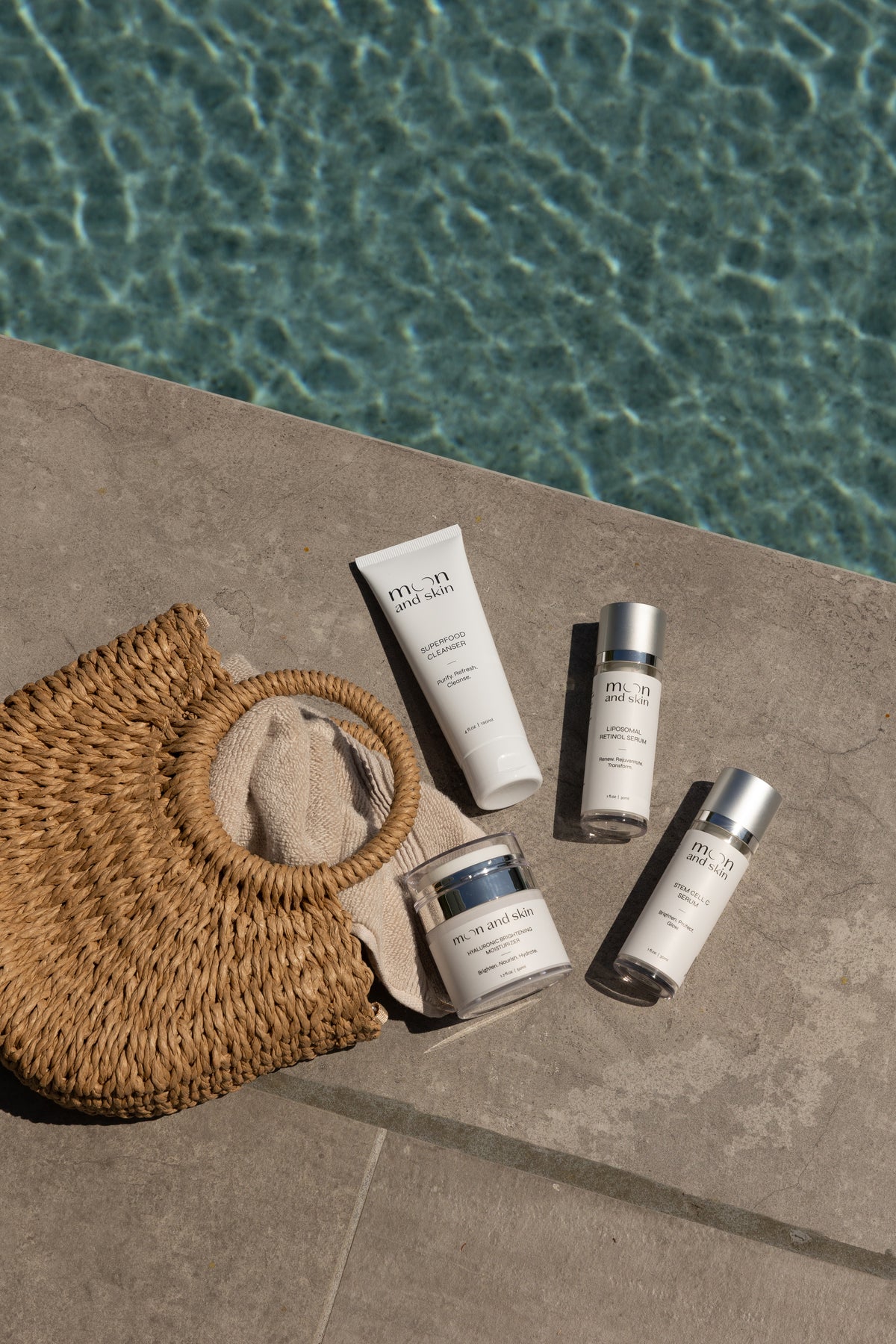सामग्री की तालिका
- परिचय
- स्किनकेयर रूटीन की मूल बातें समझना
- अपने त्वचा के प्रकार के अनुसार अपनी रूटीन बनाना
- उत्पादों की परत लगाने का महत्व
- जीवन के चरणों के दौरान अपनी रूटीन को समायोजित करना
- निष्कर्ष
- अक्सर पूछे जाने वाले प्रश्न
परिचय
कल्पना करें कि आप हर सुबह एक ताजगी भरे, चमकदार रंगत के साथ जागते हैं जो देखने में जितना अच्छा लगता है। कई के लिए, यह सपना सिर्फ एक काल्पनिकता नहीं है; यह एक समर्पित स्किनकेयर रूटीन का परिणाम है। लेकिन स्किनकेयर रूटीन वास्तव में क्या है, और यह स्वस्थ त्वचा बनाए रखने के लिए इतना महत्वपूर्ण क्यों है?
एक स्किनकेयर रूटीन एक श्रृंखला के कदमों और उत्पादों का समावेश है जो आपकी त्वचा की देखभाल के लिए डिज़ाइन किए गए हैं, इसकी अनूठी आवश्यकताओं और चिंताओं को ध्यान में रखते हुए। आज उपलब्ध उत्पादों और सलाह की प्रचुरता के साथ, यह जानना भारी हो सकता है कि कहां से शुरू करें। हालाँकि, मूल बातें समझकर आप एक व्यक्तिगत रेजिमेन बनाने के लिए सशक्त होंगे जो आपके त्वचा के प्रकार और लक्ष्यों के साथ मेल खाता है।
इस ब्लॉग पोस्ट में, हम आपको एक प्रभावी स्किनकेयर रूटीन बनाने की आवश्यकताओं के माध्यम से मार्गदर्शन करेंगे, लगातार बने रहने के महत्व को उजागर करेंगे, और यह समझाने की कोशिश करेंगे कि कैसे आपकी रेजिमेन को आपकी त्वचा के विकास के साथ बदलना है, ठीक उसी तरह जैसे चंद्रमा के चरण। अंत में, आपके पास वह ज्ञान होगा जो आवश्यक चमक प्राप्त करने के लिए चाहिए, जबकि Moon and Skin के व्यक्तित्व और प्रकृति के साथ सामंजस्य का मिशन अपनाते हुए।
हम विभिन्न पहलुओं को कवर करेंगे, जिसमें शामिल है:
- स्किनकेयर रूटीन के मूलभूत घटक।
- त्वचा के प्रकारों और चिंताओं के अनुसार अपनी रूटीन को अनुकूलित करना।
- उत्पादों की परत लगाने और समय का महत्व।
- भिन्न जीवन चरणों में त्वचा की सेहत बनाए रखने के लिए सुझाव।
साथ में, हम स्किनकेयर की सुंदरता की खोज करेंगे और यह कैसे न केवल आपकी रंगत बल्कि आपकी समग्र भलाई को भी बदल सकता है।
स्किनकेयर रूटीन की मूल बातें समझना
इसके मूल में, एक स्किनकेयर रूटीन आपकी त्वचा को साफ़ करने, सुरक्षा प्रदान करने और पोषण करने का काम करता है। जबकि रूटीन उतने सरल या जटिल हो सकते हैं जितना आप चाहते हैं, तीन बुनियादी कदम हैं जिन्हें सभी को शामिल करना चाहिए: क्लेंसिंग, मॉइस्चराइजिंग, और सुरक्षा।
1. क्लेंसिंग: किसी भी रूटीन का आधार
क्लेंसिंग किसी भी स्किनकेयर रूटीन का पहला कदम है। इसमें त्वचा की सतह से गंदगी, मेकअप और अशुद्धियों को हटाना शामिल है, जिसमें अगले उत्पादों के लिए एक साफ कैनवास सुनिश्चित किया जा सके।
क्लेंसिंग क्यों महत्वपूर्ण है?
- ब्रेकेआउट्स को रोकता है: अतिरिक्त तेल और मलबे को प्रभावी ढंग से हटाकर, क्लेंसिंग उन clogged pores को रोकने में मदद करता है जो मुँहासे का कारण बन सकते हैं।
- उत्पादों के अवशोषण को बढ़ाता है: साफ त्वचा सक्रिय अवयवों के बेहतर प्रवेश की अनुमति देती है, जिससे उनके प्रभाव में वृद्धि होती है।
क्लेंसिंग कैसे प्रभावी रूप से करें:
- सही क्लेंजर चुनें: अपने त्वचा के प्रकार के आधार पर, हल्के फोमिंग क्लेंजर, क्रीम आधारित क्लेंजर, या मेकअप के लिए तेल आधारित क्लेंजर का चयन करें।
- आवृत्ति: अपने चेहरे को दिन में दो बार—सुबह में और सोने से पहले एक बार क्लीन करने का प्रयास करें।
2. मॉइस्चराइजिंग: हाइड्रेशन आवश्यक है
मॉइस्चराइजिंग त्वचा के हाइड्रेशन और बाधा कार्य को बनाए रखने के लिए अनिवार्य है। यहाँ तक कि तैलीय त्वचा के प्रकार को भी नमी की आवश्यकता होती है, क्योंकि इस कदम को नजरअंदाज करने से तेल उत्पादन और मुँहासे बढ़ सकते हैं।
मॉइस्चराइजिंग के लाभ:
- हाइड्रेशन को लॉक इन करता है: एक अच्छा मॉइस्चराइज़र नमी को सील करने में मदद करता है और पर्यावरणीय आक्रमणकारियों के खिलाफ एक सुरक्षात्मक बाधा प्रदान करता है।
- त्वचा की बनावट में सुधार करता है: नियमित रूप से मॉइस्चराइज़र का उपयोग करने से त्वचा में नर्मी और भरापन आ सकता है।
मॉइस्चराइज़र चुनने के लिए सुझाव:
- अपनी त्वचा के प्रकार को जानें: यदि आपकी त्वचा सूखी है, तो मोटे क्रीम या तेल आधारित उत्पादों की तलाश करें। तैलीय त्वचा के लिए, हल्के, जेल आधारित मॉइस्चराइज़र का चयन करें।
- सामग्री पर विचार करें: हयालूरोनिक एसिड, ग्लिसरीन, और सेरामाइड्स जैसे मुख्य तत्वों की तलाश करें, जो त्वचा को हाइड्रेट और मजबूत करने के लिए जाने जाते हैं।
3. सुरक्षा: सनस्क्रीन अनिवार्य है
आपकी सुबह की रूटीन में अंतिम कदम हमेशा सनस्क्रीन शामिल करना चाहिए। यह आपकी त्वचा को हानिकारक यूवी किरणों से बचाने के लिए महत्वपूर्ण है, जो समय से पहले बुढ़ापे और त्वचा के कैंसर का कारण बन सकती हैं।
सनस्क्रीन का उपयोग क्यों करें?
- त्वचा को नुकसान से रोकता है: नियमित रूप से एसपीएफ का उपयोग करने से सूर्य के नुकसान का जोखिम काफी हद तक कम हो सकता है, जिसमें सूर्य के धब्बे, झुर्रियाँ, और उम्र बढ़ने के अन्य संकेत शामिल हैं।
- समान त्वचा की टोन को बढ़ावा देता है: सनस्क्रीन हाइपरपिग्मेंटेशन को रोकने में मदद करता है और अधिक समान रंगत बनाए रखता है।
सही सनस्क्रीन चुनने के लिए:
- ब्रोड-स्पेक्ट्रम सुरक्षा: UVA और UVB दोनों किरणों के खिलाफ सुरक्षा के लिए "ब्रोड-स्पेक्ट्रम" के रूप में लेबल वाले उत्पादों को खोजें।
- SPF 30 या उच्चतर: त्वचा विशेषज्ञ पर्याप्त सुरक्षा के लिए कम से कम SPF 30 वाले सनस्क्रीन के उपयोग की सिफारिश करते हैं।
अपने त्वचा के प्रकार के अनुसार अपनी रूटीन बनाना
अपने त्वचा के प्रकार को समझना एक प्रभावी स्किनकेयर रूटीन बनाने के लिए आवश्यक है। प्रत्येक त्वचा का प्रकार—सूखी, तैलीय, संयोजन, या संवेदनशील—अलग-अलग तरीके और उत्पादों की आवश्यकता होती है।
1. सूखी त्वचा
सूखी त्वचा में नमी की कमी होती है और यह तंग या फटी हुई महसूस कर सकती है।
स्किनकेयर टिप्स:
- क्रीमीय क्लेंजर का उपयोग करें: ऐसे क्रीम या तेल आधारित क्लेंजर्स का चयन करें जो आपकी त्वचा से उसके प्राकृतिक तेलों को नहीं हटाते।
- हाइड्रेशन पर ध्यान दें: हयालूरोनिक एसिड जैसे तत्वों के साथ हाइड्रेटिंग सीरम और इमोलियंट्स से भरपूर मॉइस्चराइज़र का समावेश करें।
2. तैलीय त्वचा
तैलीय त्वचा अत्यधिक सीबम उत्पादन की विशेषता है, जिससे चमक और विस्तारित पोर्स पैदा होते हैं।
स्किनकेयर टिप्स:
- हल्के उत्पाद: जेल आधारित मॉइस्चराइज़र और हल्के सीरम चुनें जो पोर्स को बंद न करें।
- स्क्रब करना: नियमित स्क्रबिंग तेल को नियंत्रित करने और ब्रेकआउट को रोकने में मदद कर सकती है, लेकिन अधिक स्क्रब करने से बचें।
3. संयोजन त्वचा
संयोजन त्वचा सूखी और तैलीय दोनों त्वचा के लक्षण प्रदर्शित करती है, सामान्यत: ट-जोन तैलीय और गाल सूखी होती है।
स्किनकेयर टिप्स:
- अपनी रूटीन को संतुलित करें: यदि आवश्यक हो तो अपने चेहरे के विभिन्न क्षेत्रों के लिए विभिन्न उत्पादों का उपयोग करें, जैसे कि ट-जोन के लिए हल्का जेल और अधिक सूखी क्षेत्रों के लिए समृद्ध क्रीम।
- हाइड्रेटिंग टोनर्स: नमी के स्तर को बनाए रखने के लिए हाइड्रेटिंग टोनर्स का समावेश करें।
4. संवेदनशील त्वचा
संवेदनशील त्वचा विभिन्न उत्पादों और पर्यावरणीय कारकों के प्रति आसानी से प्रतिक्रिया कर सकती है।
स्किनकेयर टिप्स:
- नरम सूत्र: "फ्रैगेंस-फ्री" और "हाइपोएलर्जेनिक" के रूप में लेबल वाले उत्पादों की तलाश करें।
- पैच टेस्टिंग: नए उत्पादों को आजमाते समय हमेशा पैच टेस्ट करें ताकि प्रतिकूल प्रतिक्रियाओं से बचा जा सके।
उत्पादों की परत लगाने का महत्व
आपके उत्पादों को लागू करने के क्रम को समझना उनके लाभों को बढ़ा सकता है। सामान्य नियम यह है कि उत्पादों को सबसे पतले से मोटे स्थिरता में लागू किया जाए।
1. सुबह की रूटीन परतबंदी
- क्लेंजर: अशुद्धियों को हटाने के लिए एक हल्के क्लेंजर्स के साथ शुरुआत करें।
- टोनर (वैकल्पिक): त्वचा के pH को संतुलित करने और हाइड्रेशन जोड़ने के लिए टोनर का उपयोग करें।
- सीरम: अपनी त्वचा की चिंताओं के अनुसार सक्रिय अवयवों के साथ एक हल्का सीरम लगाएं।
- मॉइस्चराइज़र: उपयुक्त मॉइस्चराइज़र के साथ हाइड्रेशन को लॉक करें।
- सनस्क्रीन: UV क्षति से सुरक्षा के लिए एक ब्रोड-स्पेक्ट्रम सनस्क्रीन के साथ समाप्त करें।
2. शाम की रूटीन परतबंदी
- मेकअप रिमूवर/क्लेंसिंग ऑयल: यदि आप मेकअप पहनते हैं, तो मेकअप को घुलाने के लिए एक क्लेंसिंग ऑयल या बाम से शुरुआत करें।
- क्लेंजर: किसी भी शेष अशुद्धियों को हटाने के लिए एक हल्के क्लेंजर से पीछा करें।
- टोनर: अपनी त्वचा की तैयारी के लिए एक हाइड्रेटिंग टोनर का उपयोग करें।
- उपचार उत्पाद: विशिष्ट चिंताओं के लिए लक्षित उपचार, जैसे मुँहासे उपचार या रेटिनॉल लगाएं।
- सीरम: अपनी त्वचा की विशेष आवश्यकताओं को ध्यान में रखते हुए एक सीरम लगाएं।
- मॉइस्चराइज़र या नाइट क्रीम: एक समृद्ध क्रीम या रात भर के मास्क के साथ नमी को सील करें।
जीवन के चरणों के दौरान अपनी रूटीन को समायोजित करना
जैसे-जैसे चंद्रमा चरणों में चलता है, आपकी त्वचा भी समय के साथ विकसित होती है। उम्र, हार्मोनल परिवर्तनों और पर्यावरणीय स्थितियों जैसे कारक आपकी त्वचा की आवश्यकताओं को प्रभावित कर सकते हैं।
- किशोरावस्था: तेल प्रबंधन और मुँहासे रोकने के लिए सरल रूटीन पर ध्यान दें, सौम्य क्लेंसिंग और तेल-मुक्त मॉइस्चराइजर्स पर जोर दें।
- 20s: बुढ़ापे के प्रारंभिक संकेतों और सूर्य के नुकसान से लड़ने के लिए एंटीऑक्सीडेंट और सनस्क्रीन शामिल करना शुरू करें।
- 30s और उसके बाद: महीन रेखाओं पर लक्षित करने और त्वचा की लोच बनाए रखने के लिए एंटी-एजिंग सामग्रियों, जैसे रेटिनॉल को शामिल करें।
निष्कर्ष
एक स्किनकेयर रूटीन बनाना और बनाए रखना एक सशक्त यात्रा है जो आपकी विशिष्टता और आपकी त्वचा की निरंतर विकसित होने वाली प्रकृति का जश्न मनाती है, बिलकुल चंद्रमा के चरणों की तरह। आवश्यक चरणों को समझकर और अपनी रूटीन को अपनी अद्वितीय त्वचा के प्रकार और आवश्यकताओं के अनुसार अनुकूलित करके, आप स्वस्थ, चमकदार त्वचा का विकास कर सकते हैं।
Moon and Skin में, हम स्किनकेयर में शिक्षा और सहयोग के महत्व में विश्वास करते हैं। हमारा मिशन आपको वह ज्ञान और स्वच्छ, विचारशील सूत्र प्रदान करना है जो आपकी त्वचा की यात्रा का सम्मान करें।
जब आप इस स्किनकेयर यात्रा पर निकलते हैं, तो याद रखें कि निरंतरता महत्वपूर्ण है। आपकी त्वचा को खूबसूरती से विकसित होने के लिए समय और देखभाल की आवश्यकता है। यदि आप अपनी स्किनकेयर आवश्यकताओं के लिए अधिक सुझाव और विशेष छूट प्राप्त करने के लिए तैयार हैं, तो हम आपको Moon and Skin पर हमारे "Glow List" में शामिल होने के लिए आमंत्रित करते हैं।
अक्सर पूछे जाने वाले प्रश्न
बेसिक स्किनकेयर रूटीन क्या है?
एक बेसिक स्किनकेयर रूटीन सामान्यत: दिन के समय में क्लेंसिंग, मॉइस्चराइजिंग, और सनस्क्रीन लगाने में शामिल होता है। शाम को, यह क्लेंसिंग और मॉइस्चराइजिंग पर केंद्रित होता है।
मुझे अपने स्किनकेयर रूटीन को कितनी बार बदलना चाहिए?
यह अनुशंसित है कि आप हर कुछ महीनों में अपने स्किनकेयर रूटीन का पुनर्मूल्यांकन करें, विशेषकर जब आपकी त्वचा मौसम, हार्मोनल परिवर्तन या अन्य कारकों के कारण बदलाव अनुभव करती है।
क्या मैं एक साथ कई उत्पादों का उपयोग कर सकता हूँ?
हाँ, उत्पादों को परत करना फायदेमंद हो सकता है, लेकिन सामग्री के प्रति सजग रहें। जलन से बचने के लिए समान रूटीन में कठोर सक्रिय तत्व (जैसे रेटिनॉल और एएचए) को मिलाने से बचें।
क्या मुझे एक अलग सनस्क्रीन की आवश्यकता है?
हाँ, प्रभावी यूवी सुरक्षा के लिए एक समर्पित सनस्क्रीन का उपयोग करना महत्वपूर्ण है, क्योंकि कई मॉइस्चराइजर्स पर्याप्त कवरेज प्रदान नहीं करते।
मैं अपनी त्वचा का प्रकार कैसे निर्धारित कर सकता हूँ?
आपकी त्वचा का प्रकार विभिन्न परिस्थितियों में आपकी त्वचा की प्रतिक्रिया को देखकर आंका जा सकता है। सूखी त्वचा तंग या फटी हुई महसूस कर सकती है, तैलीय त्वचा चमकदार दिख सकती है, संयोजन त्वचा में तैलीय और सूखी दोनों क्षेत्र होते हैं, और संवेदनशील त्वचा उत्पादों पर आसानी से प्रतिक्रिया कर सकती है।







